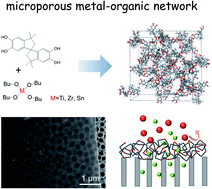Ultrathin microporous metal–organic network membranes for molecular separation†
Abstract
Microporous materials are ideal building blocks for separation membranes due to their molecular-sized pores and high porosity. However, it is challenging to assemble/grow crystalline microporous materials, such as zeolites, metal–organic frameworks (MOFs), and covalent organic frameworks (COFs), into ultrathin and defect-free selective membranes. Amorphous microporous materials, such as polymers of intrinsic microporosity (PIMs), have been deposited as ultrathin selective membranes, but their chemical stability, especially in various organic solvents, may be a concern. Herein, for the first time we report microporous metal–organic networks (mMONs) formed via alcoholysis reaction between contorted/rigid organic units with catechol groups and metal linkers. mMONs exhibit similar microporosity to existing microporous materials, high chemical stability and structural integrity against various chemical environments, because of the contortion and rigidity of the organic units and covalent bonds between metal linkers and catechol groups. An interfacial process is developed to fabricate ultrathin mMON membrane (30–120 nm). Compared with the reported organic solvent nanofiltration (OSN) membranes with a similar molecular weight cut-off (MWCO), mMON membranes exhibit similar or higher solvent permeance.

- This article is part of the themed collection: 2021 Journal of Materials Chemistry A most popular articles


 Please wait while we load your content...
Please wait while we load your content...
